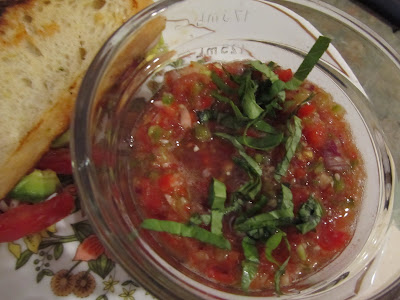Full disclosure: I'm not completely sure this dish is actually from Uzbekistan.
Facts I knew about Uzbekistan
As you can see, I was off to a flying start, here. Enter the Internet!
Facts I learned about Uzbekistan after 10 minutes of research on Wikipedia
The more you know!
Armed with this knowledge, I was even less sure about the legitimacy of this dish, as is contains neither mutton nor noodles. However, it did taste good, and all of the ingredients seemed legit to my uninformed and possibly stereotypical view of Uzbek cuisine (root vegetables and dill and rye are kind of Russiany, right? And Uzbekistan was kind of Russiany for a while...).
First, steam up some chopped kale (cooked spinach would work, too—just make sure to drain the spinach before using). Once cooked, set aside.
Next, get about a cup of cooked chickpeas (canned are fine). In a large saute pan, heat up some oil over medium heat; I used some chili oil, but any oil would work (you could always add a bit of crushed pepper to spice it up). Once the oil is hot, add the chickpeas and cook, stirring occasionally, until they've started to brown.
While the chickpeas are cooking, start your grain of choice. Rice is the suggested accompaniment, but I used rye berries because they seemed more interesting and no less traditional (traditional used rather loosely). You want roughly half as much grain as bean, so I used about 1/4 c. rye berries to 1/2 c. water, bringing it all to a boil and then simmering until the grains were tender.
Once the chickpeas are all crispy and golden, empty them out onto a paper towel-covered plate, to absorb some of the excess oil. Wipe down your saute pan, add a little more oil, and return to the heat. When the oil is hot, add a tablespoon each of black sesame seed and caraway seed, plus any crushed pepper of your choosing, to the extent your tastebuds can handle (I used a sprinkle of Aleppo pepper). Chop up half an onion, finely mince a couple of cloves of garlic, and peel and chop the root vegetables of your choice (I used two small carrots, sliced into rounds, along with a turnip and rutabaga that were roughly diced into quarter-inch cubes). When the seeds begin to sputter, add the onion and stir, cooking until it is just softened. Then mix in the garlic; when the garlic is fragrant, add the carrots/turnips/rutabaga/whatever, plus a teaspoon each of ground cumin and coriander, and stir to coat. Pour in 1/4 c. water and cover, letting it simmer until the vegetables are almost tender.
Finely chop a large bunch of dill (a good 1/2 c., packed). Uncover the pan and add the kale; let cook until almost all of the liquid (if any remains) has evaporated, then add a quick slurp of cider vinegar. Mix, taste for salt and adjust as necessary, then add half of the chopped dill; let it all cook, stirring occasionally, until the turnips and rutabagas are done. Mix in the cooked rye berries and chickpeas, along with the rest of the dill, and let everything heat through. Do a final taste and adjust for salt, dill, or vinegar as needed.
Remove the pan from the heat and stir through a large dollop of sour cream or yogurt. Sprinkle on even more dill, if that's what you fancy. The dill's the limit.
The rye berries help make this a solid dish, but it also goes well with hunks of bread, and I imagine it wouldn't be remiss wrapped up in a pita or similar bread-like contraption. Or, enjoy with actual hunks, if you happen to know any.
Facts I knew about Uzbekistan
- It is a former Soviet Socialist Republic.
- It is very mountainous and dry.
- Most Uzbeks are Muslim.
- Uzbeks are very nosy people with bones in their brains.
- The president named the months of the year after himself. (Actually, this was Turkmenistan, and it was really only one month named after him, and one named after his mother, but still it's a little strange.)
As you can see, I was off to a flying start, here. Enter the Internet!
Facts I learned about Uzbekistan after 10 minutes of research on Wikipedia
- It is one of two doubly-landlocked countries. (The other is Lichtenstein.)
- There is a very good bicyclist from Uzbekistan, named Djamolidine Abdoujaparov, who is also known as "The Terror of Tashkent" for his propensity to weave back and forth in crowded sprints.
- Uzbekistan is the world's third-largest exporter of cotton.
- The average summer high temperature is 104ºF (40ºC) and the average winter low temperature is –9ºF (–23ºC).
- Uzbeks eat a lot of sheep and noodles.
The more you know!
Armed with this knowledge, I was even less sure about the legitimacy of this dish, as is contains neither mutton nor noodles. However, it did taste good, and all of the ingredients seemed legit to my uninformed and possibly stereotypical view of Uzbek cuisine (root vegetables and dill and rye are kind of Russiany, right? And Uzbekistan was kind of Russiany for a while...).
First, steam up some chopped kale (cooked spinach would work, too—just make sure to drain the spinach before using). Once cooked, set aside.
Next, get about a cup of cooked chickpeas (canned are fine). In a large saute pan, heat up some oil over medium heat; I used some chili oil, but any oil would work (you could always add a bit of crushed pepper to spice it up). Once the oil is hot, add the chickpeas and cook, stirring occasionally, until they've started to brown.
While the chickpeas are cooking, start your grain of choice. Rice is the suggested accompaniment, but I used rye berries because they seemed more interesting and no less traditional (traditional used rather loosely). You want roughly half as much grain as bean, so I used about 1/4 c. rye berries to 1/2 c. water, bringing it all to a boil and then simmering until the grains were tender.
Once the chickpeas are all crispy and golden, empty them out onto a paper towel-covered plate, to absorb some of the excess oil. Wipe down your saute pan, add a little more oil, and return to the heat. When the oil is hot, add a tablespoon each of black sesame seed and caraway seed, plus any crushed pepper of your choosing, to the extent your tastebuds can handle (I used a sprinkle of Aleppo pepper). Chop up half an onion, finely mince a couple of cloves of garlic, and peel and chop the root vegetables of your choice (I used two small carrots, sliced into rounds, along with a turnip and rutabaga that were roughly diced into quarter-inch cubes). When the seeds begin to sputter, add the onion and stir, cooking until it is just softened. Then mix in the garlic; when the garlic is fragrant, add the carrots/turnips/rutabaga/whatever, plus a teaspoon each of ground cumin and coriander, and stir to coat. Pour in 1/4 c. water and cover, letting it simmer until the vegetables are almost tender.
Finely chop a large bunch of dill (a good 1/2 c., packed). Uncover the pan and add the kale; let cook until almost all of the liquid (if any remains) has evaporated, then add a quick slurp of cider vinegar. Mix, taste for salt and adjust as necessary, then add half of the chopped dill; let it all cook, stirring occasionally, until the turnips and rutabagas are done. Mix in the cooked rye berries and chickpeas, along with the rest of the dill, and let everything heat through. Do a final taste and adjust for salt, dill, or vinegar as needed.
Remove the pan from the heat and stir through a large dollop of sour cream or yogurt. Sprinkle on even more dill, if that's what you fancy. The dill's the limit.
The rye berries help make this a solid dish, but it also goes well with hunks of bread, and I imagine it wouldn't be remiss wrapped up in a pita or similar bread-like contraption. Or, enjoy with actual hunks, if you happen to know any.














